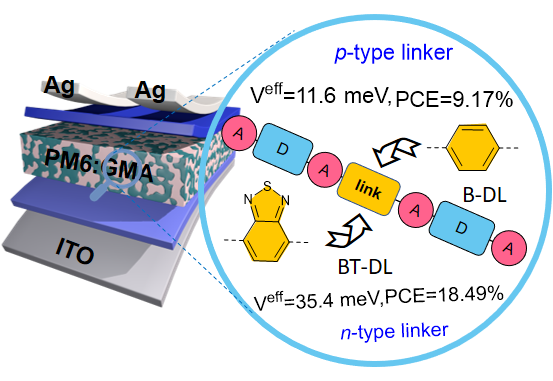Polymer solar cells (PSCs) have garnered significant attention due to their advantages of being lightweight, flexible, capable of being made into semi-transparent devices, and solution-processable. Recently, the design and synthesis of A-D-A type small molecule acceptor (SMAs) have advanced PSCs greatly, achieving power conversion efficiencies exceeding 19%. However, blending SMAs with polymer donors often leads to stability issues in PSCs due to the crystallization and diffusion characteristics of SMAs. Constructing giant molecular acceptors by covalently linking SMA units through bridging units can effectively increase the glass transition temperature of the acceptor materials, thereby establishing a stable active layer morphology and effectively addressing this problem. Nevertheless, the structural design and optimization of bridging units in chemical synthesis remain challenging.
Professor Zhi-guo Zhang from Beijing University of Chemical Technology (BUCT), in collaboration with Professor Zhigu Yuanping Yi from the Institute of Chemistry, Chinese Academy of Sciences (ICCAS), reported on dimeric giant acceptors using benzothiadiazole (n-type) and phenyl (p-type) as bridging units. The study found that giant acceptors constructed with n-type bridging units exhibited superior performance in terms of intermolecular superexchange coupling and intramolecular charge transfer, thereby achieving higher power conversion efficiencies. This research provides crucial molecular design strategies for developing high-performance PSCs. The first authors of this paper are Hongyuan Fu and Qingyuan Wang. The paper was selected by the journal editors as a Very Important Paper (VIP).

Dimeric Giant Molecule Acceptors Featuring n-type Linker: Enhancing Intramolecular Coupling for High-Performance Polymer Solar Cells. Fu H, Wang Q, Chen Q, Zhang Y, Meng S, Xue L, Zhang C, Yi Y, Zhang Z-G. Angew. Chem. Int. Ed. 2024, 63(20), e202403005., DOI: 10.1002/anie.202403005,https://doi.org/10.1002/anie.202403005


